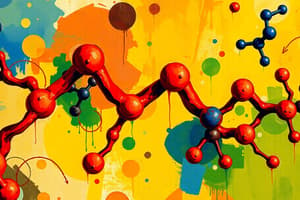Podcast
Questions and Answers
What characteristic distinguishes saturated fatty acids from unsaturated fatty acids?
What characteristic distinguishes saturated fatty acids from unsaturated fatty acids?
- Saturated fatty acids are composed of nonpolar molecules.
- Saturated fatty acids have only single bonds between carbon atoms. (correct)
- Saturated fatty acids have at least one double bond.
- Saturated fatty acids contain three fatty acids.
Which macromolecule is primarily used for energy storage in animals?
Which macromolecule is primarily used for energy storage in animals?
- Glycogen (correct)
- Chitin
- Starch
- Cellulose
In nucleic acids, what type of bond is responsible for linking nucleotides together?
In nucleic acids, what type of bond is responsible for linking nucleotides together?
- Peptide bond
- Hydrogen bond
- Glycosidic linkage
- Phosphodiester linkage (correct)
What is the monomer of proteins?
What is the monomer of proteins?
Which statement accurately describes the secondary structure of proteins?
Which statement accurately describes the secondary structure of proteins?
What type of linkage is formed between two monosaccharides?
What type of linkage is formed between two monosaccharides?
Which of the following correctly describes the structure of phospholipids?
Which of the following correctly describes the structure of phospholipids?
What is the primary function of cellulose in plants?
What is the primary function of cellulose in plants?
Flashcards
Carbohydrate monomer
Carbohydrate monomer
A single sugar molecule, like glucose.
Protein structure levels
Protein structure levels
Proteins have four levels of structure: primary, secondary, tertiary, and quaternary.
Nucleotide monomer
Nucleotide monomer
The building block of nucleic acids, made of a phosphate, nitrogenous base, and sugar.
Phospholipid structure
Phospholipid structure
Signup and view all the flashcards
Saturated fatty acid
Saturated fatty acid
Signup and view all the flashcards
Unsaturated fatty acid
Unsaturated fatty acid
Signup and view all the flashcards
Glycosidic linkage
Glycosidic linkage
Signup and view all the flashcards
Base Pairing in DNA
Base Pairing in DNA
Signup and view all the flashcards
Study Notes
Carbohydrates
- Composed of C, H, and O in a 1:2:1 ratio
- Monomer: monosaccharide (e.g., glucose)
- Structural carbohydrates: cellulose (plant cell walls), chitin (fungal cell walls and exoskeletons)
- Storage carbohydrates: starch (plants), glycogen (animals)
- Disaccharides: formed from two monosaccharides via glycosidic linkages (e.g., sucrose, lactose, maltose)
- Starch vs. cellulose: differ in the way glucose monomers are linked (alpha vs. beta linkages)
Proteins
- Composed of C, H, O, N, and sometimes S
- Monomer: amino acid
- Amino acids linked via peptide bonds (carboxyl to amino group)
- Levels of protein structure: primary (sequence of amino acids), secondary (alpha helix or beta pleated sheet), tertiary (final 3D structure), quaternary (interactions between multiple polypeptide chains)
- Protein function varies greatly depending on the specific amino acid sequence and 3D structure
Nucleic Acids
- Composed of C, H, O, N, and P
- Monomer: nucleotide (phosphate, pentose sugar, nitrogenous base)
- Types: DNA (deoxyribose sugar, double-stranded), RNA (ribose sugar, single-stranded)
- Nitrogenous bases: purines (adenine, guanine), pyrimidines (cytosine, thymine, uracil)
- DNA and RNA have specific base pairings (A-T, A-U, G-C)
Lipids
- Composed of C, H, and O
- All lipids are nonpolar
- Types: fats, phospholipids, steroids
- Fats: composed of glycerol and three fatty acids (saturated or unsaturated)
- Phospholipids: composed of glycerol, two fatty acids, and a phosphate group; have polar heads and nonpolar tails (amphipathic)
- Steroids: four fused carbon rings; examples include cholesterol, hormones (e.g., testosterone, estrogen)
Studying That Suits You
Use AI to generate personalized quizzes and flashcards to suit your learning preferences.
Related Documents
Description
This quiz covers the essential building blocks of life: carbohydrates, proteins, and nucleic acids. Learn about the structure, function, and types of these macromolecules, as well as key concepts like glycosidic linkages and peptide bonds. Perfect for students studying biology at any level.



